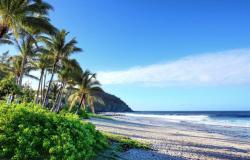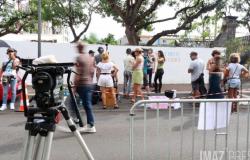After several months of waiting for the acquisition of professional equipment, the marine observatory of Reunion Island is starting a new stage in its research in partnership with the Department aimed at working on marine pollution. This Monday, October 21, 2024, the first results of this research are released: the plankton collected for research contain microplastics, very bad news for the island’s marine fauna. A second, more in-depth study will be carried out on plankton in order to determine the size of the microplastics contained in this species and how this waste impacts the plankton (Photo: rb/wwwImazpress.com)
After several months of waiting for the acquisition of professional equipment (plankton nets, flow meters, binoculars and state-of-the-art microscopes, etc.), studies of the marine environment were able to begin on the biodiversity of plankton and the estimation of pollution of marine waters. surface in Reunion Island by microplastic particles.
On Saturday October 12 in the afternoon, a team left at sea from the port of Saint-Gilles-les-Bains to carry out the first tests of this equipment on a route 6 km long in total. For these tests, 2 transects were carried out in a South-North then North-South direction, at a speed of 2 knots (or approximately 4 km/h) and at a distance of between 1.7 and 2.76 km from the edge.
To validate this route in the first North route, a first 4 km long route was made between St Gilles-les-Bains and Cap Homard, and the second on the same return route, this time 2 km long between the Cap Homard and Cap des Aigrettes.
The very first results are in:
– Plankton could be collected, but rather in small quantities considering the distance traveled and the volume of water filtered (1,178 m3 of sea water filtered just under the surface), consisting essentially of very small crustaceans of the type “copepods” and “shrimp” and few microalgae,
– Surprisingly, a good quantity of mini sea snails on the surface, while their shells were sinking into the manta net collector,
– A 3.5 cm fish larva was also captured,
– Finally, bad news… some microplastic particles have already been observed in the samples (the blue particles in the photo with the fish larva).
In addition to these first results, 2 notable macro-wastes could be identified at sea during the entire trip (outside the planktonic filtration zone): a wooden pallet and an aluminum can (coming from Reunion), both ‘next to each other, about 10 km off the coast of Saint-Paul.
The planktonic samples thus collected will be studied more precisely soon, in order to know precisely:
– Biodiversity and abundance of plankton by species
– The abundance and size of microplastic particles
– The distribution of species and waste around Reunion Island
All this data will be added to the ongoing operation of the marine observatory “100 km of coastline specific to Reunion Island” also announced in the same BIC project financed by the Department of Reunion Island. But also to the other BIC project “Marine biodiversity in Reunion”, which, at the end of 2024, will allow the Reunion marine observatory to present for the first time its “OcéaRun” game for discovering the marine environment in 4D, a educational and fun tool which will bring to fruition an extract of more than 2 years of development.
News from Reunion Island, Reunion Marine Observatory, Microplastics in seedlings






